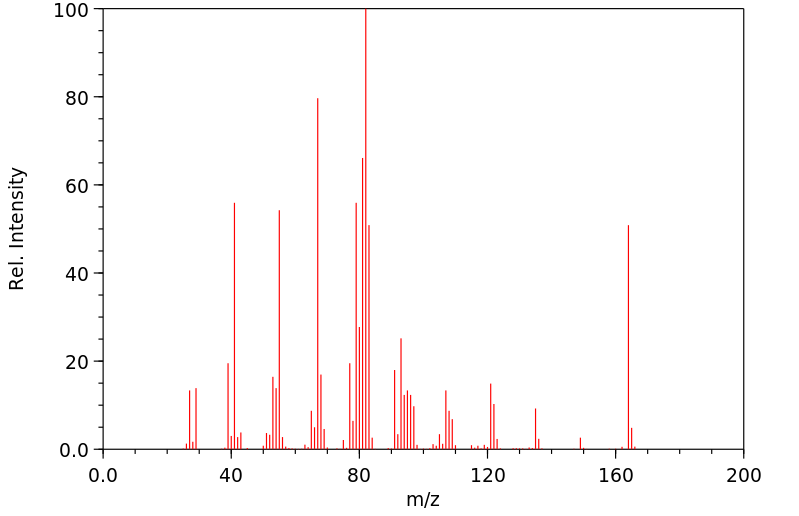1-环己基环己烯 | 3282-54-0
中文名称
1-环己基环己烯
中文别名
——
英文名称
1-cyclohexyl-1-cyclohexene
英文别名
1-Cyclohexyl-cyclohexen-(1);1-Cyclohexyl-cyclohexen;1-cyclohexylcyclohexene;cyclohexyl-1-cyclohexene;Cyclohexene, 1-cyclohexyl-
CAS
3282-54-0
化学式
C12H20
mdl
MFCD00053264
分子量
164.291
InChiKey
RFFCUDDJJDOFLS-UHFFFAOYSA-N
BEILSTEIN
——
EINECS
——
-
物化性质
-
计算性质
-
ADMET
-
安全信息
-
SDS
-
制备方法与用途
-
上下游信息
-
文献信息
-
表征谱图
-
同类化合物
-
相关功能分类
-
相关结构分类
物化性质
-
熔点:-43 °C
-
沸点:236-237.5 °C(Press: 755 Torr)
-
密度:0.9071 g/cm3(Temp: 19.4 °C)
计算性质
-
辛醇/水分配系数(LogP):4.5
-
重原子数:12
-
可旋转键数:1
-
环数:2.0
-
sp3杂化的碳原子比例:0.833
-
拓扑面积:0
-
氢给体数:0
-
氢受体数:0
安全信息
-
海关编码:2902199090
SDS
上下游信息
-
上游原料
中文名称 英文名称 CAS号 化学式 分子量 —— 2-(cyclohexen-1-yl)-1-cyclohexanol 65181-96-6 C12H20O 180.29 2-(1-环己烯基)环己酮 2-(1-cyclohexenyl)cyclohexanone 1502-22-3 C12H18O 178.274
反应信息
-
作为反应物:描述:参考文献:名称:Truffault, Bulletin de la Societe Chimique de France, 1936, vol. <5> 3, p. 442,452摘要:DOI:
-
作为产物:参考文献:名称:Schrauth; Goerig, Chemische Berichte, 1923, vol. 56, p. 1904摘要:DOI:
文献信息
-
Promising Ni/Al-SBA-15 catalysts for hydrodeoxygenation of dibenzofuran into fuel grade hydrocarbons: synergetic effect of Ni and Al-SBA-15 support作者:Sharafadeen Gbadamasi、Tammar Hussein Ali、Lee Hwei Voon、Abdulazeez Yusuf Atta、Putla Sudarsanam、Suresh K. Bhargava、Sharifah Bee Abd HamidDOI:10.1039/c5ra27526a日期:——has been undertaken with the aim of designing promising noble-metal-free catalysts for efficient hydrodeoxygenation (HDO) of dibenzofuran (DBF) into fuel grade hydrocarbons. For this, various Ni/Al-SBA-15 catalysts with different Si/Al (50, 60, 70 and 80) mole ratios were synthesized and their catalytic performance was tested for HDO of DBF in a batch reactor. The catalysts were systematically characterized进行这项工作的目的是设计有前途的无贵金属催化剂,以将二苯并呋喃(DBF)高效加氢脱氧(HDO)转化为燃料级碳氢化合物。为此,合成了具有不同Si / Al(50、60、70和80)摩尔比的各种Ni / Al-SBA-15催化剂,并在间歇反应器中测试了它们的催化性能,以评估DBF的HDO。使用XRD,N 2-吸附-解吸,拉曼,H 2 -TPR,NH 3 -TPD,XRF和FESEM技术对催化剂进行了系统表征。活动结果表明,DBF的HDO通过镍位点上的苯加氢,然后裂解酸性位点上的C-O键,生成不饱和烃。Ni位点上的不饱和烃的进一步氢化得到双环己烷作为主要产物。值得注意的是,除Ni / SBA-15和Ni / Al-SBA-15(80)(Si / Al摩尔比= 80)催化剂外,所有催化剂的DBF转化率均为100%,分别显示97.97%和99.31% 。在这项研究中注意到的一个重要观察结果是,将Al掺入Ni
-
Effective hydrodeoxygenation of dibenzofuran by a bimetallic catalyst in water作者:Peng Dong、Guo-ping Lu、Chun CaiDOI:10.1039/c5nj02164b日期:——hydrodeoxygenation (HDO) of dibenzofuran (DBF) catalyzed by a bimetallic nickel/platinum (Ni/Pt) catalyst in water was demonstrated at 200 °C and 1.2 MPa hydrogen (H2) pressure. The bimetallic catalysts prepared by a wet chemical method exhibit prominent activity that overcomes the limitations of use of a single Ni or Pt metal catalyst. The yield of HDO products can be up to 90%. Reaction results indicate
-
Highly Selective Formation of Cyclopentanol through Liquid-Phase Cyclopentene Hydration over MCM-22 Catalysts作者:Duangamol Nuntasri、Peng Wu、Takashi TatsumiDOI:10.1246/cl.2002.224日期:2002.2MCM-22 catalyst exhibits an extremely high shape selectivity not observed on other zeolites of MFI, MOR and BEA structures, in that it effectively catalyzes the liquid-phase hydration of cyclopentene at a conversion up to 10% and a cyclopentanol selectivity as high as 99%.
-
Triphosgene and DMAP as Mild Reagents for Chemoselective Dehydration of Tertiary Alcohols作者:Moshood O. Ganiu、Alexander H. Cleveland、Jarrod L. Paul、Rendy KartikaDOI:10.1021/acs.orglett.9b01959日期:2019.7.19The utility of triphosgene and DMAP as mild reagents for chemoselective dehydration of tertiary alcohols is reported. Performed in dichloromethane at room temperature, this reaction is readily tolerated by a broad scope of substrates, yielding alkenes preferentially with the (E)-geometry. While formation of the Hofmann products is generally favored, a dramatic change in alkene selectivity toward the
-
New Insights into the Second Generation Antihistamines作者:Garry M. Walsh、Lucio Annunziato、Nelly Frossard、Klaas Knol、Sten Levander、Jean-Marie Nicolas、Maurizo Taglialatela、Michael D. Tharp、Jean P. Tillement、Henk TimmermanDOI:10.2165/00003495-200161020-00006日期:——Second generation antihistamines are recognised as being highly effective treatments for allergy-based disease and are among the most frequently prescribed and safest drugs in the world. However, consideration of the therapeutic index or the benefit/risk ratio of the H1 receptor antagonists is of paramount importance when prescribing this class of compounds as they are used to treat non-life threatening conditions. There are many second generation antihistamines available and at first examination these appear to be comparable in terms of safety and efficacy. However, the newer antihistamines in fact represent ahererogeneous group of compounds, having markedly differing chemical structures, adverse effects, half-life, tissue distribution and metabolism, spectrum of antihistaminic properties, and varying degrees of anti-inflammatory effects. With regard to the latter, there is growing awareness that some of these compounds might represent useful adjunct medications in asthma therapy. In terms of safety issues, the current second generation grouping includes compounds with proven cardiotoxic effects and others with the potential for adverse drug interactions. Moreover, some of the second generation H1 antagonists have given cause for concern regarding their potential to cause a degree of somnolence in some individuals. It can be argued, therefore, that the present second generation grouping is too large and indistinct since this was based primarily on the concept of separating the first generation sedating compounds from nonsedating H1 antagonists. Although it is too early to talk about a third generation grouping of antihistamines, future membership of such a classification could be based on a low volume of distribution coupled with a lack of sedating effects, drug interactions and cardiotoxicity.第二代抗组胺药被认为是治疗过敏性疾病的有效药物,并且是全球最常用和最安全的药物之一。然而,在开处方时考虑H1受体拮抗剂的治疗指数或收益/风险比至关重要,因为它们用于治疗非危及生命的疾病。目前有许多第二代抗组胺药可供选择,初步查看其安全性和疗效似乎是相当可比的。然而,较新一代的抗组胺药实际上代表了一组异质化的化合物,具有显著不同的化学结构、不良反应、半衰期、组织分布和代谢、抗组胺特征的谱系,以及不同程度的抗炎效果。关于抗炎效果,越来越多的人意识到这些化合物可能在哮喘治疗中作为有用的辅助药物。在安全性问题方面,目前的第二代抗组胺药中包括一些具有已知心脏毒性影响的药物,以及一些具有潜在不良药物相互作用的药物。此外,一些第二代H1拮抗剂引起了人们对其在某些个体中引起嗜睡的潜在风险的担忧。因此,可以认为目前的第二代药物分组过于庞大且不明确,因为这一分类主要是基于将第一代镇静药物与非镇静H1拮抗剂分开的概念。虽然谈论第三代抗组胺药的分组还为时尚早,但未来这类分类的成员资格可能基于较低的分布量,以及缺乏镇静作用、药物相互作用和心脏毒性。
表征谱图
-
氢谱1HNMR
-
质谱MS
-
碳谱13CNMR
-
红外IR
-
拉曼Raman
-
峰位数据
-
峰位匹配
-
表征信息
同类化合物
高密聚乙烯
香叶醇
顺式3-甲基-2-己烯
顺式-5-癸烯
顺式-5-甲基-2-己烯
顺式-5-庚烯-1-炔
顺式-4-癸烷
顺式-4-甲基-2-戊烯
顺式-4-甲基-2-戊烯
顺式-3-癸烯
顺式-3-甲基-3-己烯
顺式-3-甲基-2-庚烯
顺式-3-戊烯-1-炔
顺式-3,4-二甲基-3-己烯
顺式-3,4-二甲基-2-戊烯
顺式-3,4-二甲基-2-戊烯
顺式-2-甲基-3-己烯
顺式-2-壬烯
顺式-2-丁烯-D1
顺式-1.1.1-三甲基-2-丁烯
顺式-1-甲基-2-环丙基乙烯
顺式-1-甲基-2-乙烯基环戊烷
顺式-1-环戊基-1-辛烯
顺式-1-氘代-3-甲基-1-丁烯
顺式-(9ci)-2,3,3a,7a-四氢-4-(1-甲基乙基)-1H-茚
顺式-(2-丁烯基)环丙烷
顺式,顺式-2,4-己二烯
顺-环辛烯
顺-9-二十一碳烯
顺-6-十三碳烯
顺-5-甲基-1,3,6-庚三烯
顺-4-辛烯
顺-4-壬烯
顺-3-辛烯
顺-3-甲基-2-戊烯
顺-3-壬烯
顺-3-十三碳烯
顺-2-辛烯
顺-2-癸烯
顺-2-戊烯
顺-2-庚烯
顺-2-己烯
顺-2-丁烯
顺-2,2-二甲基-3-己烯
顺-1,3-戊二烯
顺,顺-1,9-环十六烷二烯
顺,顺,顺-环癸-1,3,5-三烯
间戊二烯
间二(4-吡啶基)苯
镁,二-2-丁烯基-







